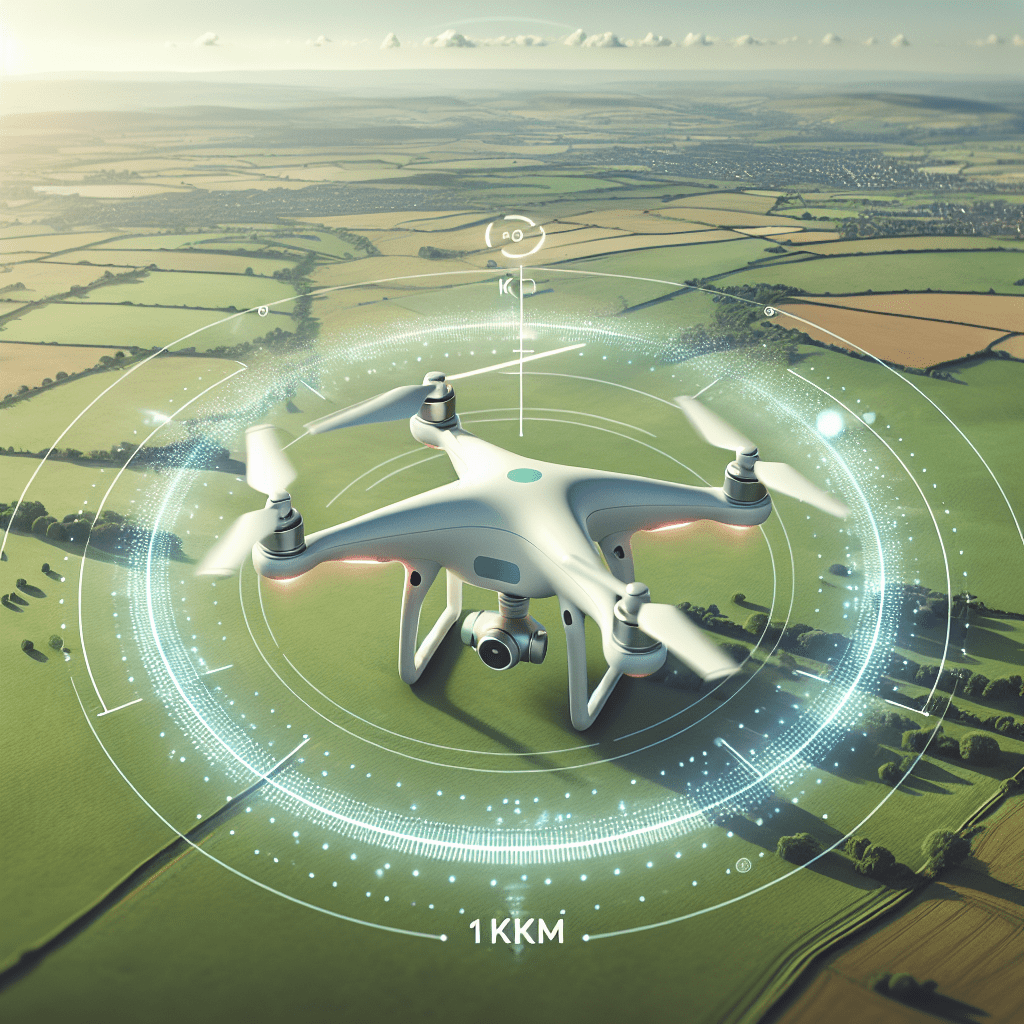Drone Range Basics: Aero 3 Lite’s 1km Limit in the UK
In This Article
- Always fly within Visual Line of Sight (VLOS) as per CAA rules.
- Expect effective control up to 700m in optimal conditions.
- Avoid urban flying if aiming for long-distance stability.
- Maintain good antenna orientation and line-of-sight elevation.
- Regularly update firmware and calibrate compass before each flight.
Why Understanding Drone Range Matters
Key Terms for Beginners
When diving into the world of recreational UAVs, understanding Drone Range Basics is essential for safe and optimal flying. In simple terms, drone range refers to the maximum distance a drone can fly from the controller or remote while still maintaining a stable connection. For hobbyists in the UK, this isn’t just a matter of capability—it’s also about legality and practical use. Terms such as ‘line of sight’, ‘transmission frequency’, ‘interference’, and ‘return-to-home’ become critical when working with entry-level drones like the Aero 3 Lite.
Most consumer drones operate on 2.4GHz or 5.8GHz frequencies, each with benefits and vulnerabilities. The range advertised—such as the Aero 3 Lite’s 1km—is often measured under ideal conditions: open fields, no signal congestion, and minimal obstructions. However, in real-world flying environments across the UK, variables like trees, buildings, and electronic noise can massively affect your drone’s actual communication range. Thus, Drone Range Basics are crucial knowledge for preventing flyaways and preserving both your equipment and compliance with UK Civil Aviation Authority regulations.

Aero 3 Lite Overview
Specs, Connectivity & Use Case
The Aero 3 Lite is designed as an accessible, entry-level drone for UK hobby flyers seeking reliable performance without overwhelming complexity. Weighing under 249g, it avoids many legal restrictions related to heavier drones, making it ideal for beginners. The advertised 1km range is facilitated by a dual-band WiFi connection, operating primarily at 2.4GHz due to better penetration and reach in suburban environments.
It supports HD video transmission up to 720p within closer ranges and features GPS positioning for accurate returns and stability in light winds. Battery life hovers around 20 minutes under normal flight circumstances, which aligns well with its range capability. In practice, the Aero 3 Lite meets the expectations of casual hobbyists, offering an intuitive flight experience with a moderate but manageable learning curve. Ideal use cases include parkland filming, farm surveying, and learning how to pilot small UAVs within legal constraints.
What 1km Range Means Practically
Interference, Law, and Terrain Constraints
At first glance, a 1km range appears generous for hobbyists, yet Drone Range Basics clarify why the real-world usage is more complex. In optimal flying areas—flat rural fields or clifftop coastlines—you may approach the advertised one kilometre. But in practice, various factors reduce this effective range. For instance, environmental interference from dense forests, urban WiFi networks, and even birds can disrupt your signal before it reaches the advertised 1km threshold.
Additionally, UK legal regulations hinder exploiting full-range capabilities. Visual Line of Sight (VLOS) requirements from the CAA stipulate that drone pilots must maintain uninterrupted eye contact with their UAV. Practically, this limits useful range to approximately 500 metres—or much less in built-up areas or poor visibility. Despite the best intentions of drone designers, these legal caveats mean that understanding Drone Range Basics ensures both lawful flying and the safety of your aircraft.
Why Signal Dropouts Happen Before 1km
The Role of Obstructions and Noise
Signal dropouts are one of the most common concerns among new drone operators. Despite a unit like the Aero 3 Lite boasting a 1km range, obstructions and environmental noise often change the game. Trees, buildings, vehicles, and even wireless routers can interfere with the transmission signal, often forcing a ‘return-to-home’ activation well before maximum range is reached.
This is a result of electromagnetic interference (EMI), which disrupts the signal integrity between drone and controller. Urban environments are particularly susceptible, with overlapping WiFi and Bluetooth signals flooding the 2.4GHz band that most entry-level drones rely on. Weather is another significant factor. High humidity and wind decrease signal stability. Fortunately, the Aero 3 Lite manages interruptions well; it uses positioning data to safely hover or return home should the signal falter—an underrated benefit for pilot confidence.
Legal Guidelines for UK Flyers
What the CAA Requires
The Civil Aviation Authority (CAA) enforces strict guidelines for UAV operation across the UK. Under its rules, flying within your drone’s technical range isn’t enough—you must adhere to sightline laws. The CAA mandates that all unmanned aircraft must be flown within the operator’s Visual Line of Sight (VLOS), generally defined as approximately 400-500 metres depending on visibility conditions and drone size.
Further, you must avoid flying over people, near airports, or above 400ft above ground level. If your drone is equipped with a camera—and the Aero 3 Lite is—you’ll also need to comply with additional Data Protection Act requirements. Operators of drones over 250g (applicable if you modify your Aero 3 Lite) must register for an Operator ID and labelling. While these rules may constrain full use of a 1km range, they also foster safer skies, particularly in crowded or residential environments. For a full breakdown, refer to Revolutionary AI advancements in digital marketing, which links directly to the CAA’s unmanned aircraft guidelines.
Tips to Maximise Reliable Range
Line-of-Sight, Orientation, and Power Saving
There are several reliable strategies to ensure your Aero 3 Lite reaches or approaches its maximum functional distance. First and foremost is maintaining a clear Line of Sight (LOS); any obstruction between you and the drone, including trees, hills, or buildings, will likely cause rapid signal degradation. Elevating your take-off position—like from small mounds or viewpoints—can extend radio range substantially.
Orientation also matters; always position the drone’s antennae (usually embedded within its legs or body) to face the controller. Antenna alignment can mean the difference between abrupt signal loss at 400m versus stable flight at 800m. Battery conservation is another underrated factor. Operating your drone with a near-depleted battery can prompt early return functions that limit distance. Keep your firmware updated and calibrate your compass before launches to improve signal resilience. For additional optimisation suggestions, check out Learn more about Drone Collection and Flight Guidance.
Comparison: Aero 3 Lite vs Other Entry-Level Drones
Is the 1km Range Competitive?
When placed alongside its peers, the Aero 3 Lite’s 1km advertised range places it squarely in the competitive bracket for budget beginner drones. Devices such as the Ryze Tello offer only 100m range, while the Holy Stone HS110D expands this to around 300m. The DJI Mini 2 SE—though considerably pricier—boasts up to 10km using OcuSync transmission. Therefore, in its price category, Aero 3 Lite’s reach is commendable.
It’s crucial to note that many users never utilise more than half of their drone’s range due to both legal limits and fear of connection loss. Here, the Aero 3 Lite offers a user-friendly sweet spot: a usable range long enough for scenic shots and mapping, but not so long that signal dropout becomes a routine menace. It balances affordability with performance, which is why it remains among top recommendations in our beginner drone guides at Read a related article.
Ideal Flying Environments in the UK
Where to Avoid Dropouts Safely
Your chosen flying location significantly influences how much of the Aero 3 Lite’s 1km range you can utilise. Wide open spaces like Dartmoor, Yorkshire Dales, and many managed National Trust properties (with permission) offer ideal conditions. These areas provide flat terrain, reduced signal interference, and clear sightlines which are essential for achieving anything close to maximum range.
In contrast, dense city settings, woodlands, and coastal cliffs with unpredictable airflow can severely limit signal reliability. Large metal structures and electrical lines also cause interference. Consider starting in sports fields or disused airstrips that are legally accessible to flyers. Early morning hours or late afternoons, when ambient WiFi interference is lower, also prove to be optimal flying windows.
User Experiences with Signal Stability
What Hobby Flyers Say
Feedback from Aero 3 Lite users across UK drone forums and Reddit communities paints a picture of generally positive flight stability—when flying within line-of-sight parameters. Many hobbyists note solid control up to 700-800 metres in open areas, with automatic return functions kicking in if the signal is lost. Reports indicate that maintaining vertical altitude of at least 50 metres helps with signal longevity, especially in uneven terrain.
Of course, there are outliers. Pilots attempting to fly across dense forested areas or near industrial parks often report significant signal loss. One recurring suggestion is to check local electromagnetic maps or use spectrum analyser apps before flight, ensuring minimal surrounding broadcast interference. Overall, users appreciate the Aero 3 Lite for its balance of quality and simplicity—just don’t expect full use of the 1km range in every environment.
Expert Verdict: Is 1km Enough?
Final Take for UK Pilots
From an expert’s perspective, the 1km advertised range of the Aero 3 Lite is more than sufficient for hobby-level flying within the UK’s legal and practical frameworks. Given the VLOS requirement and the signal limitations imposed by geography and interference, most pilots rarely, if ever, reach the maximum theoretical limit of their craft. However, that extra range acts as a buffer, increasing the margin for safe flight and giving added confidence in signal retention.
What makes the Aero 3 Lite appealing is its consistent performance within 500-700m, aligning realistically with what most users actually need. It’s not designed to compete with professional inspection drones or high-end aerial cinematography rigs. Instead, it offers a solid baseline that prioritises safety, simplicity, and learning—all key pillars in responsible drone ownership.
“Beginners don’t need 10km of range—they need reliable control, and that’s where the Aero 3 Lite shines.” – UK Drone Instructors Alliance
Conclusion: Best Practices for Aero 3 Lite Range
Mastering Drone Range Basics is essential for getting the most out of your Aero 3 Lite drone in the UK. While the promoted 1km range stands as a technical ceiling, real-world operations suggest a more modest figure is both typical and legally appropriate under CAA law. By sustaining line of sight, avoiding interference hotspots, and respecting battery thresholds, pilots can confidently maximise range without compromising control or violating regulations.
Whether you’re a newcomer eager to film sweeping coastal cliffs or a hobbyist mapping rural farmland, the Aero 3 Lite offers room to grow within a safe, stable range. Use each flight to build awareness of environmental constraints and fine-tune your technique, and you’ll find the Aero 3 Lite offers far more than its budget-tier status suggests.
Great guide on aero-3-lite-1km-range-explained-uk-hobby-flyers – Community Feedback
How far can the DJI Air 3 fly away from you?
The DJI Air 3 is advertised with a maximum range of up to 20 km in ideal conditions using the O4 transmission system. However, in the UK, maximum legal visual line of sight and local interference usually mean much shorter practical ranges. Always fly within visual line of sight and comply with UK drone laws.
What is the range of the Air3?
DJI Air 3’s maximum range is stated as 20 km, but real-world flights often see less due to obstacles, interference, and legal limits. Maintaining a clear line of sight between your drone and controller is essential for the best range and signal reliability.
How far can a drone go without losing signal?
A drone can fly up to its advertised range—such as 1 km with the Aero 3 Lite—but signal dropouts can occur sooner in urban areas, near power lines, or behind obstacles. To avoid losing signal, fly in open spaces, maintain controller orientation, and keep the drone within sight.
What is the longest range hobby drone?
Some hobby drones can exceed transmission distances of 10 km, such as advanced models from DJI. However, most hobbyist-level drones like Aero 3 Lite are designed for shorter, safer ranges around 1 km—ideal for beginners and UK regulations.

